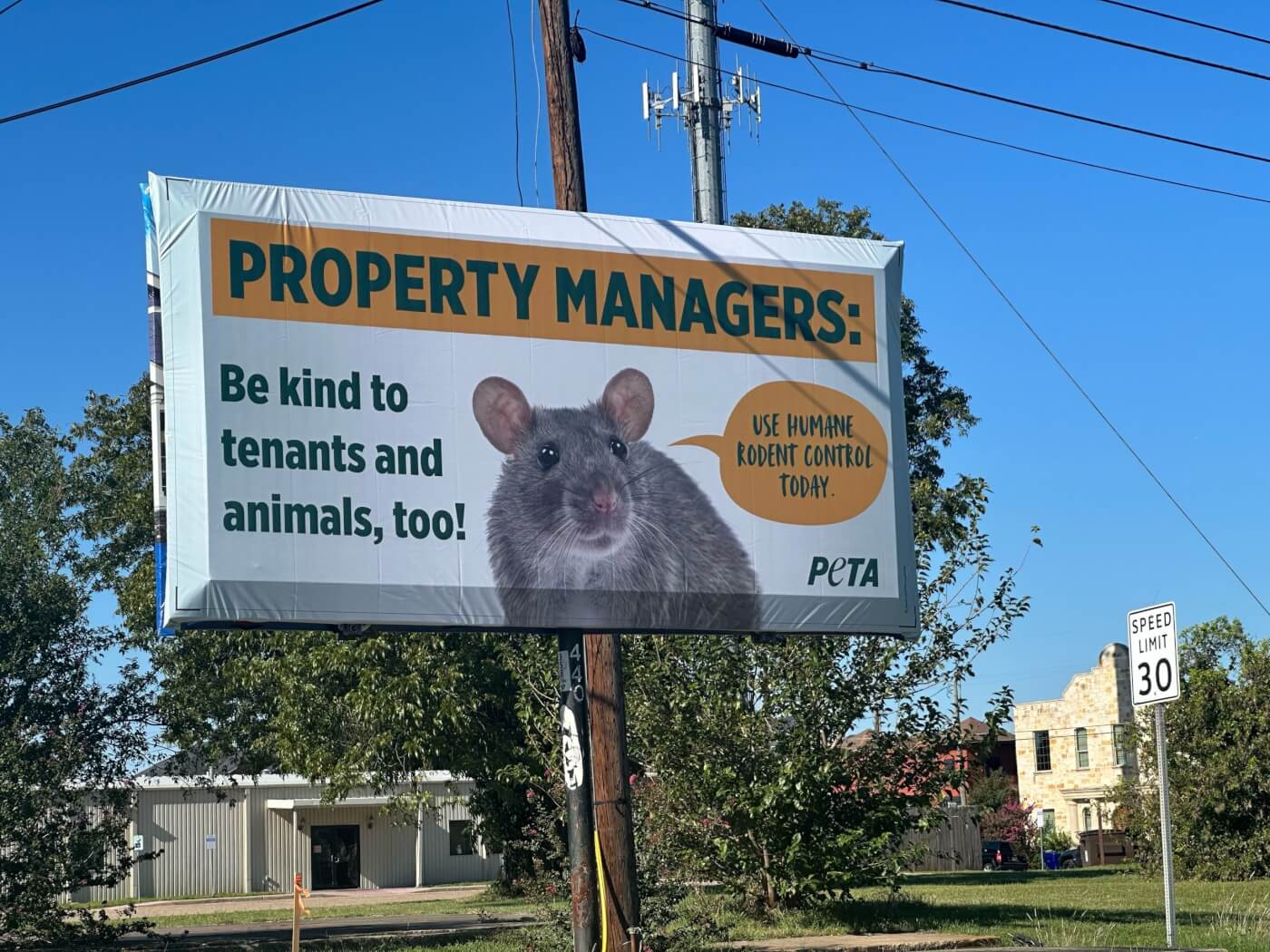PETA to Waco, Texas, Landlords: ‘Use Humane Rodent Control Today!’
After learning that students at Texas’ Baylor University submitted complaints regarding mice and rats at an off-campus apartment complex, Park Place Waco, PETA stepped in to help landlords and residents implement humane solutions.

In an article published in early September in the university’s student newspaper, The Baylor Lariat, one student alleged that the building management placed glue traps in his apartment. Glue traps are extremely cruel devices that slowly kill sensitive rats and mice.
We sent letters to Ron Gatehouse, the CEO of student housing contractor Park7 Group, and to Nick Madincea, Baylor’s student body president, urging them to condemn the use of glue traps. We also offered students tips on humane rodent control so that they could remove unwanted animals from their homes and relocate them to safe areas—and prevent animals from entering in the first place.
Our actions were successful, as Park7 responded to our letter and informed us that it had implemented many of our suggestions, which included cutting down additional vegetation near the building and having a rodent-control company inspect it and seal entryways. Park7 also informed us that it hadn’t seen or heard of any further rodent activity since mid-September. Madincea also thanked us for reaching out.
In October, we placed two billboards in Waco to serve as a reminder to all landlords that mice and rats deserve to be treated with respect and compassion. The ads read, “Property Managers: Be Kind to Tenants and Animals, Too. Use Humane Rodent Control Today.”

Why You Should NEVER Use Glue Traps
Animals caught in glue traps desperately struggle to escape, which causes them to become even more helplessly stuck. The glue often rips off their fur, feathers, or skin. Some animals even chew off their own limbs in an attempt to free themselves. It can take days for trapped animals to die from exhaustion, injury, shock, dehydration, asphyxiation, starvation, or blood loss—an undeniably cruel fate for anyone to endure. Those who survive may be crushed to death in the garbage, which is where manufacturers of glue traps direct consumers to “dispose” of them.
In addition to being cruel, lethal traps and poisons are not long-term solutions for removing mice or rats from your home. When rodents are killed, the survivors breed faster, which causes an increase in the population. And the devices fail to address the source of the problem: If holes aren’t plugged up and attractants aren’t removed, more animals will move in to take the place of those who have been killed.
You may not want rats and mice in your home, but they still deserve your empathy. Here are some humane methods for rodent control:
Humane Rodent Control Tips for All Residents, Homeowners, and Building Managers
- Contain food in chew-proof containers, made of metal or glass, and keep garbage tightly lidded, even indoors. Keep surfaces, floors, and cabinets free of crumbs and spills. Consider moving some foods from the cupboard to the refrigerator.
- Feed companion animals indoors, and then pick up their dishes when they have finished eating.
- Trim back vegetation around buildings, and seal any holes larger than a quarter inch in diameter, cracks in the walls and floors, and spaces around doors, windows, and plumbing.
- Monitor rodent activity by using a flashlight to identify entry points and frequented areas. Look specifically for droppings, chewed areas, nests, and stored/cached food. Placing ammonia-soaked rags in areas where indications of animals or droppings are seen will drive them out.
- Rats and other small animals cannot tolerate the scent or taste of pepper. Make a mixture of salad oil, horseradish, garlic, and plenty of cayenne pepper. Let this mixture sit for four days, strain it into a spray bottle, and spray it in frequented areas. It won’t harm curious animals, but it will drive them away. Mothballs and peppermint oil–soaked cotton balls are also great rodent repellents.
- Once animals are gone, use foam sealant, steel wool, hardware cloth, or metal flashing to seal entry points.
- After rodent-proofing the building, live-trap and remove any rats or mice still inside. Use a commercially available, cruelty-free Havahart trap or make your own. You can find humane, reusable Smart Mousetraps in our online catalog at PETA.com.
- Check the trap hourly, and release any captured rodents within 100 yards—so as not to disorient them—of where they were caught.
Show Compassion to Rats and Mice
Rats and mice are smart and family-oriented, and they can recognize their names when they’re called. They deserve to be treated with compassion and respect—not killed and discarded. Show empathy to them by never using glue traps or poisons and by always choosing humane methods of rodent control.
You can also help by telling companies like Lowe’s and The Home Depot to stop selling cruel glue traps:

